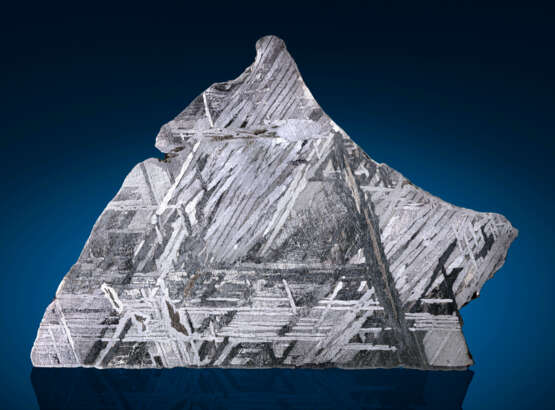ID 927058
Лот 67 | NOTABLE SLICE OF A SEYMCHAN METEORITE
Оценочная стоимость
$ 3 000 – 5 000
Seymchan meteorites possess what is among the more-resplendent crystalline patterns of any meteorite. This exquisite natural design, referred to as a Widmanstätten pattern, is the result of the intergrowth of two iron-nickel minerals, kamacite and taenite. Molten metal deep within the core of the asteroid crystallized as taenite during cooling. As temperatures dropped further, small kamacite crystals slowly began to grow within the taenite. Millions of years are required for this crystalline lattice to form and so the appearance of this pattern is diagnostic in the identification of an iron meteorite; different meteorites have different patterns (see lots 11, 26 and 38). It’s the concentration of nickel that determines the type of pattern that will form, and this singularly dazzling lattice is unique to meteorites containing about 6%-18% nickel. Seymchan is among the most rust-resistant of iron-rich meteorites, in no small part due its moderately high concentration of iridium, the second densest element and the most corrosion-resistant metal known.
This slice is etched on both sides; in a quick glance it appears as if the bottom is cut, but a closer look reveals it’s not — the rim of the meteorite’s exterior is seen on the tapered bottom edge. The meteorite from which this slice was removed naturally split apart along a crystalline plane. This complete slice also has a notable earthly provenance. It is from the collection of a fossil expert who cut and prepared this part slice from a mass he recovered following his initial trip to Seymchan in an effort to determine if more material could be found decades after the initial discovery. The news of numerous specimens recovered inspired dozens of Russian meteorite hunters, some with large teams, to journey to Seymchan in recent years. This partial slice originates from a mass that helped ignite a march to Siberia for what will forever be the one of the most popular and least-expensive meteorites of this generation. And the latter is changing; the Seymchan meteorite strewn field is now reportedly depleted.
Christie's would like to thank Dr. Alan E. Rubin at the Department of Earth, Planetary, and Space Sciences, University of California, Los Angeles for his assistance in preparing this catalogue.
196 x 271 x 3mm (7.75 x 10.75 x 0.1 in.) and 1011.1 grams (2.25 lbs)
| Адрес торгов |
CHRISTIE'S 20 Rockefeller Plaza 10020 New York США | ||||||||||||||
|---|---|---|---|---|---|---|---|---|---|---|---|---|---|---|---|
| Предосмотр |
| ||||||||||||||
| Телефон | +1 212 636 2000 | ||||||||||||||
| Факс | +1 212 636 4930 | ||||||||||||||
| Условия использования | Условия использования | ||||||||||||||
| Транспортировка |
Почтовая служба Курьерская служба Самовывоз | ||||||||||||||
| Способы оплаты |
Банковский перевод | ||||||||||||||
| Часы работы | Часы работы
|



